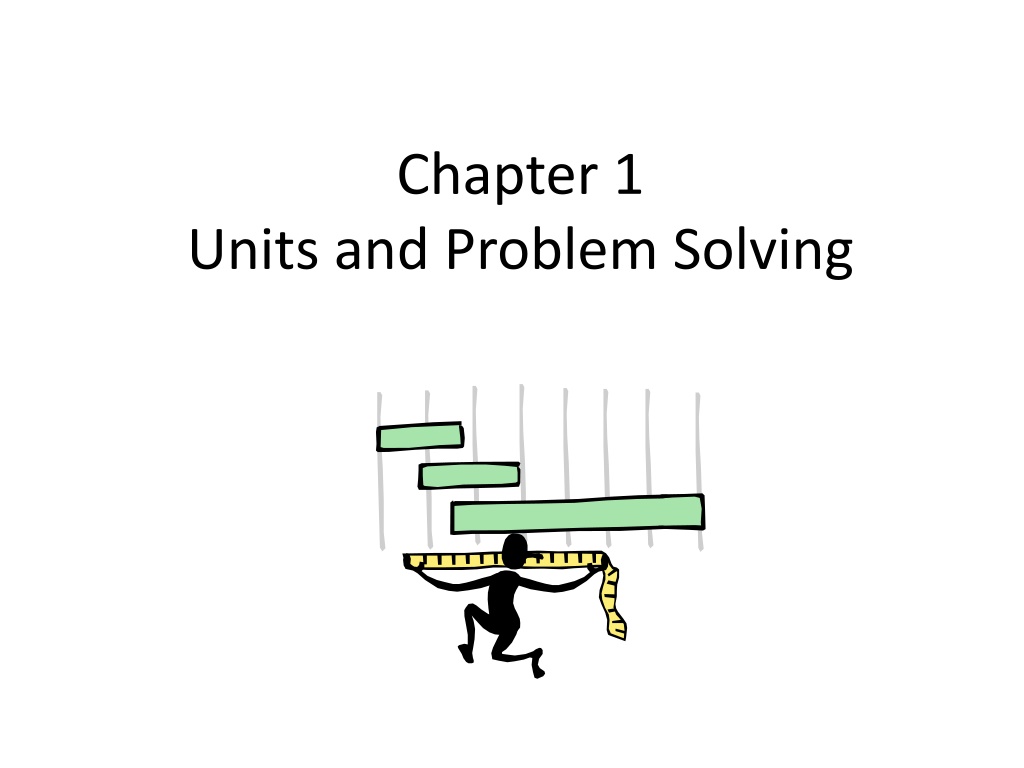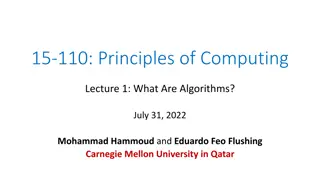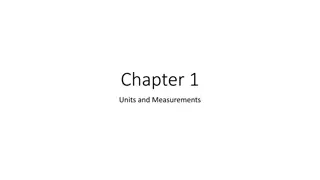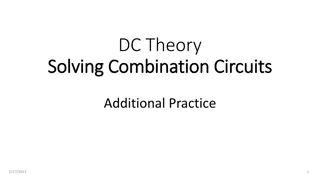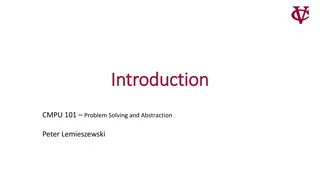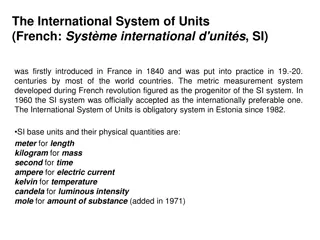Chapter 1 Units and Problem Solving
In this chapter, we delve into the International System of Units (SI) and Dimensional Analysis, essential concepts in physics. The SI system provides a standardized way to measure and describe objects and phenomena, while Dimensional Analysis allows us to check the correctness of equations based on dimensions. Explore the fundamental units, derived units, and the application of unit analysis to ensure dimensional consistency in physics equations.
Download Presentation

Please find below an Image/Link to download the presentation.
The content on the website is provided AS IS for your information and personal use only. It may not be sold, licensed, or shared on other websites without obtaining consent from the author.If you encounter any issues during the download, it is possible that the publisher has removed the file from their server.
You are allowed to download the files provided on this website for personal or commercial use, subject to the condition that they are used lawfully. All files are the property of their respective owners.
The content on the website is provided AS IS for your information and personal use only. It may not be sold, licensed, or shared on other websites without obtaining consent from the author.
E N D
Presentation Transcript
Chapter 1 Units and Problem Solving
Homework for Chapter 1 Read Chapter 1 HW 1: pp. 26-31: 2,3,8,16,18,19, 28,29,38,39,52,54,56, 62, 68, 73, 74, 75.
Warmup Perhaps the most recognizable equation in physics comes form Einstein s theory of relativity: E = mc2. It is the cornerstone of understanding nuclear energy reactions and has guided astrophysicists in their development of the Big Bang theory. Einstein even liked to answer questions about life analytically. Once, when asked for advice about how to be successful, he replied If A is success in life, then A = x + y + z. Work is x, y is play and z is _ _ _ _ _ _ _ _ _ _ _ _ _ _ _ _ _ _ _ _ . (7 letters) (4 letters) (5 letters) (4 letters) Solve the letter tile puzzle to find out what z is. G Y U T H S H O U R K E E U T M O P I N Phamous Phrases VIII (Physics Warmup #152)
Warmup: Solution Einstein even liked to answer questions about life analytically. Once, when asked for advice about how to be successful, he replied If A is success in life, then A = x + y + z. Work is x, y is play and z is _ _ _ _ _ _ _ _ _ _ _ _ _ _ _ _ _ _ _ _ . (7 letters) (4 letters) (5 letters) (4 letters) Solve the letter tile puzzle to find out what z is. K E E P I N G Y O U R M O U T H S H U T Phamous Phrases VIII (Physics Warmup #152)
1.1 -1.3 International System of Units (SI) Objects and phenomena are measured and described using standard units, a group of which makes up a system of units. - example: British System (feet, pounds) - SI is a modernized version of the metric system, base 10 SI has seven base or fundamental units. A derived unit is a combination of the base units. ex: meters per second
1.4 Dimensional Analysis The fundamental or base quantities, such as length [L] , mass [M] , and time [T] are called dimensions. Dimensional Analysis is a procedure by which the dimensional correctness of an equation can be checked. Both sides of an equation must not only be equal in numerical value, but also in dimension. Dimensions can be treated like algebraic quantities. Units, instead of dimensional symbols, may be used in unit analysis.
1.4 Dimensional Analysis Dimensional or Unit Analysis can be used to 1) check whether an equation is dimensionally correct, i.e., if an equation has the same dimension or units on both sides. 2) find out the dimension or units of derived quantities. Example 1.1: Check whether the equation x = at2 is dimensionally correct, where x is length, a is acceleration, and t is time interval.
1.4 Dimensional Analysis Example 1.1: Check whether the equation x = at2 is correct, where x is length, a is acceleration, and t is time interval. variable description dimension unit Solution: x length [L] m [L] / [T] 2 m/s2 a acceleration t time [T] s Dimensional analysis: left side of equation = right side of equation [L] x [T] 2 = [L] [T] 2 [L] The dimension of the left side is equal to the right, so the equation is dimensionally correct. Warning: dimensionally correct does not necessarily mean the equation is correct. Unit analysis: Units of the left side are m Units of the right side are (m/s2)(s2) = m Check
1.5 Conversion of Units A quantity may be expressed in other units through the use of conversion factors. Any conversion factor is equal to 1, so multiplying or dividing by this factor does not alter the quantity. Determine the correct conversion factor by dimensional (unit) analysis. Example 1.3: A jogger walks 3200 meters every day. What is this distance in miles? 1 mile = 1609 meters, therefore, you may multiply by ( 1 mi ) or (1609 m) (1609 m) (1mi) but, which one to choose? Unit analysis to the rescue (3200 m ) x ( 1 mi ) = 1.99 mi 2.0 mi. 1 (1609 m)
1.5 Conversion of Units Example 1.4: A car travels with a speed of 25 m/s. What is the speed in mi/h (miles per hour)? Solution: the conversion factor (1 mi / 1609 m), to convert meters to miles and (3600 s / 1 h) to convert seconds to hours. Here we need to convert meters to miles and second to hours. We can use (25 m ) x ( 1 mi ) x (3600 s) = 56 mi ( 1 s ) (1609 m) ( 1 h ) h We can also use the direct conversion (1 mi/h = 0.447 m/s). (25 m ) x ( 1 mi /h ) = 56 mi ( 1 s ) (0.447 m/s) h
Check for Understanding a. What is the difference between standard units and a system of units? Standard units are things like meters, seconds, newtons. A group of standard units make a system of units, such as metric, English, or SI. b. What is SI and what are the 3 main base units? SI is a newer version of the metric system, which is base-10. The three main units are m, kg, s. c. What does the prefix kilo- mean? 1000 d. What does the prefix centi- mean? 10-2 million or 106 e. What does the prefix mega- mean? f. What does the prefix micro- mean? What Greek letter is used? 10-6 10-3 g. What does the prefix milli- mean? h. Why would I use dimensional or unit analysis? to make sure my formula is correct or to find the units of my answer
1.6 Significant Figures Exact numbers have no uncertainty or error ex: the 100 used to calculate percentage ex: the 2 in the equation c = 2 r Measured numbers have some degree of uncertainty or error. When calculations are done with measured numbers, the error of measurement is propagated, or carried along. The number of significant figures (or digits) in a quantity is the number of reliably known digits it contains. There are some basic rules that can be used to determine the number of significant digits in a measurement.
1.6 Significant Figures Definition: All the valid digits in a measurement, the number of which indicates the measurement s precision (degree of exactness). also called significant figures, or sig figs Use the Atlantic & Pacific Rule to determine the sig figs. PACIFIC ATLANTIC OCEAN OCEAN
1.6 Significant Figures If the Decimal is Absent Count from the Atlantic side from the first non-zero digit. Decimal is Present Count all digits from the Pacific side from the first non-zero digit.
1.6 Significant Figures Examples: 421 Decimal is absent -> Atlantic; three significant figures 421 000 Decimal is absent -> Atlantic; three significant figures 42.100 Decimal is present -> Pacific; five sig figs 4.201 four sig figs 0.421 three sig figs 0.000421 three sig figs
1.6 Significant Figures To eliminate doubt, write the number in scientific notation. 4.2100 x 105 five sig figs 4.21 x 105 three sig figs A bar placed above a zero is also acceptable. 4, 210, 000 five sig figs 4, 210, 000 seven sig figs To avoid confusion, for the purpose of this course we will consider numbers with trailing zeros to be significant. ex: 20 s has two sig figs, even if it is not written as 2.0 x 101 s
1.6 Significant Figures When you perform any arithmetic operation, it is important to remember that the result never can be more precise than the least-precise measurement. The final result of an addition or subtraction should have the same number of decimal places as the quantity with the least number of decimal places used in the calculation. Example: 23.1 4.77 125.39 + 3.581 156.841 Round to 156.8 (one decimal place)
1.6 Significant Figures To multiply or divide measurements, perform the calculation and then round to the same number of significant digits as the least-precise measurement. (3.64928 x 105) (7.65314 x 107) (5.2 x 10-3) (5.7254 x 105) least precise measurement = (3.64928 x 105) x (7.65314 x 107) (5.2 x 10-3) (5.7254 x 105) = 9.3808 x 109 = 9.4 x 109 because the least precise measurement has 2 sig figs.
1.6 Significant Figures Rules for Rounding Off In a series of calculations, carry the extra digits through to the final answer, then round off. ROUND ONLY ONCE AT THE END OF YOUR CALCULATION! If the digit to be removed is: <5, the preceding stays the same. example: 1.33 rounds to 1.3 5 or greater, the preceding digit increases by 1. example: 1.36 rounds to 1.4. Example: Round 24.8514 to three figures. Look at the fourth figure. It is a 5, so the preceding digit increases by 1. The original number becomes 24.9
1.6 Significant Figures Percent error is used to determine accuracy, or the variation of a measurement compared to the accepted or theoretical value. Percent error = measured value accepted value 100% accepted value Example: The accepted value for the acceleration due to gravity is 9.80 m/s2. The experimental results on the first trial was 8.50 m/s2. What was the percent error? 8.50 m/s2 9.80 m/s2 x 100% = 13.3% 9.80 m/s2 Percent deviation is used to determine precision, or the closeness of measurements to each other. Percent deviation = measured value average value 100% average value
1.7 Problem Solving Problem solving is a skill learned by practice, practice, practice. The procedure you use will be unique; develop what works for you. HOWEVER, This is a procedure you can follow and build on. 1. Say it in words (talk it out). Read the problem carefully and analyze it. Write down the given data (knowns) and what you are to find (unknowns). 2. Say it in pictures Draw a diagram, if appropriate. 3. Say it in equations. Select your equations. 4. Simplify the equations. Isolate the unknown variable before plugging in numbers.
1.7 Problem Solving 5. Check the units. Do this before calculating. 6. Plug in numbers and calculate; check significant figures. Box your answer with units. 7. Check the answer. Is it reasonable? Mrs. P s Tip: Always show your work; partial credit is a beautiful thing.
Check for Understanding a. What is the difference between an exact number and a measured number? An exact number has no uncertainty or error, and a measured number does. b. What is the Atlantic / Pacific Rule? If the decimal is absent, count from the Atlantic side from the 1st non- zero digit. If the decimal is present, count from the Pacific side from the 1st non-zero digit. c. What is the rule for addition and subtraction? The result of your calculation can never be more precise than the least precise measurement, meaning places after the decimal point. d. What is the rule for multiplication and division? The product or quotient has the same number of sig figs as the least precise number.
Check for Understanding e. What are the rules for rounding? Look at the figure to the right of the figure that is to be last. -If it is less than 5, drop it and all the figures to the right of it. -If it is greater than or equal to 5, increase by 1 the number to be rounded. f. Describe a good problem solving strategy. -Talk it out -Draw a picture -Write your equations -Isolate the unknown variable before plugging in numbers -Check the units -Calculate and solve -Does the answer make sense? HW 1: pp. 26-31: 2,3,8,16,18,19, 28,29,38,39,52,54,56, 62, 68, 73, 74, 75.
1.6 Significant Figures Percent error is used to determine accuracy, or the variation of a measurement compared to the accepted or theoretical value. Percent error = measured value accepted value 100% accepted value Example: The accepted value for the acceleration due to gravity is 9.80 m/s2. The experimental results on the first trial was 8.50 m/s2. What was the percent error? 8.50 m/s2 9.80 m/s2 9.80 m/s2 x 100% = 13.3%
